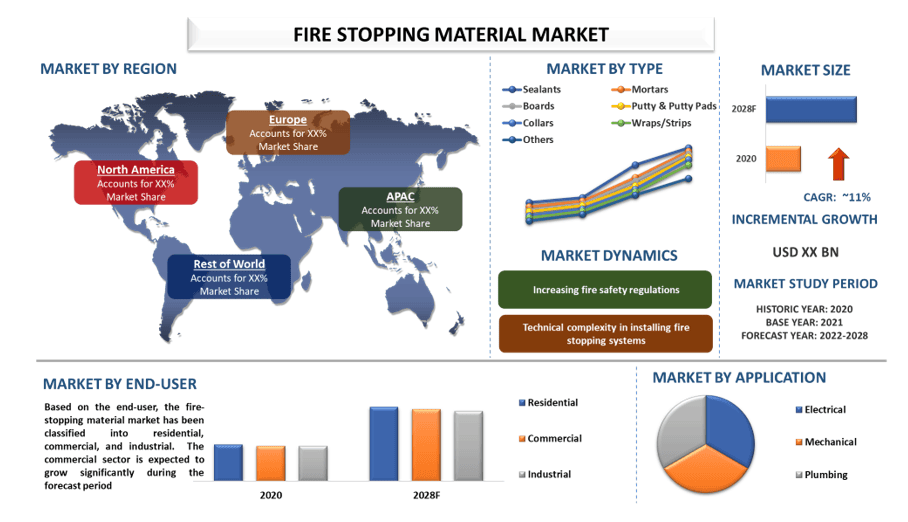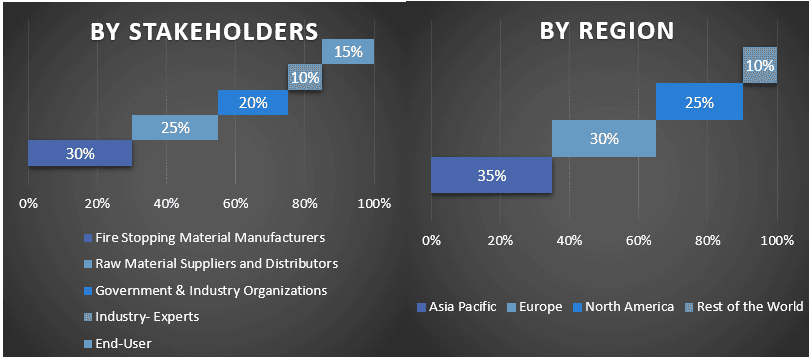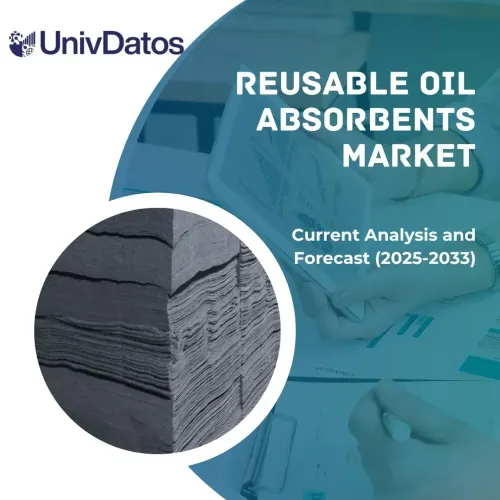
글로벌 화재 방지재 시장은 2022-2028년 예측 기간 동안 약 11%의 상당한 성장률을 보일 것으로 예상됩니다. 화재 방지재는 수동 내화의 기본 부분으로도 알려져 있습니다. 이는 건물 내 ‘구획’ 간의 화재 확산을 억제하기 위해 벽과 바닥 사이의 개구부와 조인트를 내화성 재료로 채우는 과정을 의미합니다. 최근 몇 년 동안 화재 방지재는 화재, 연기 및 열이 여러 구성 요소를 통과하는 것을 방지하는 데 사용이 증가함에 따라 수요가 급격히 증가했습니다. 이러한 구성 요소는 내화성 및 발포성 재료는 물론 시멘트 모터, 실리콘, 미네랄 섬유 및 고무 화합물로 만들어집니다. 예를 들어, 2020년 5월에 BASF는 Gasoil 공급 원료를 처리하는 FCC 장치에서 경질 올레핀 생산을 향상시켜 정유소에 더 많은 프로필렌을 공급하기 위해 유동 촉매 분해(FCC) 첨가제 제품인 ZEAL™을 출시했습니다.
3M Company, BASF SE, Lloyd Insulations India Ltd., Hilti Corporation, Knauf Insulation, Morgan Advanced Materials, Saint-Gobain S.A., Sika AG, Specified Technologies Inc., Abesco Fire Ltd.는 시장의 주요 업체 중 일부입니다. 하이테크 및 혁신적인 제품/기술로 고객을 지원하기 위해 이러한 업체들이 여러 건의 M&A와 파트너십을 체결했습니다.
보고서에 제시된 인사이트
“유형 중 퍼티 및 퍼티 패드 화재 방지재 카테고리가 예측 기간 동안 더 높은 CAGR을 기록할 것입니다.”
유형에 따라 시장은 실란트, 모르타르, 보드, 퍼티 및 퍼티 패드, 칼라, 랩/스트립 및 기타로 분류됩니다. 퍼티 및 퍼티 패드 화재 방지재 카테고리는 예측 기간 동안 더 높은 CAGR을 기록할 것입니다. 이는 점토 또는 반죽과 질감이 유사한 높은 가소성을 가진 재료의 유형으로, 주로 건설 중 틈새를 밀봉하는 데 사용됩니다. 또한 이 시장은 관통 주변의 개구부를 밀봉하고 연기, 유해 가스 및 화재의 통과를 방지하는 빠른 작동 발포성 특성을 가진 최고의 탄성 페이스트입니다.
“애플리케이션 중 전기 부문이 2020년에 시장에서 상당한 점유율을 차지할 것입니다.”
애플리케이션을 기준으로 시장은 전기, 기계 및 배관으로 분류됩니다. 이 중 전기 부문은 2020년에 시장에서 상당한 점유율을 차지했습니다. 이는 주로 전 세계적으로 건설 산업이 성장하면서 전기 장비에 대한 수요가 증가했기 때문입니다. 실란트, 모르타르 및 퍼티는 화재를 막는 데 도움이 되는 건설 건물 내의 전선을 덮는 데 많이 사용되는 제품 중 일부입니다.
“최종 사용자 중 상업 부문이 예측 기간 동안 더 높은 CAGR을 기록할 것입니다.”
최종 사용자를 기준으로 화재 방지재 시장은 주거, 상업 및 산업으로 분류되었습니다. 상업 카테고리는 예측 기간 동안 화재 방지재의 채택이 더 높을 것으로 예상됩니다. 이는 주로 쇼핑몰, 학교, 병원 등과 같이 이러한 지역에 많은 인파가 모이는 시설이 많기 때문입니다. 또한 상업 건설은 선진국과 개발도상국 모두에서 가장 많이 증가하는 건설 중 하나입니다. 또한 선진국에서는 식료품점, 약국 및 퀵 서비스 레스토랑의 건설이 증가하고 있으며 개발도상국에서는 병원, 학교 및 대학, 소매점의 건설이 상업 건설 부문을 주도하고 있습니다.
“아시아 태평양 지역이 시장에서 상당한 점유율을 차지할 것입니다.”
2020년에는 아시아 태평양 지역이 예측 기간 동안 상당한 CAGR로 성장할 것으로 예상됩니다. 이는 주로 이 지역에서 건설 및 건축 부문이 증가하면서 이 지역에서 화재 방지재에 대한 수요가 증가했기 때문입니다. 또한 인구 증가와 새로운 기술 및 제품 개발과 같은 요인들이 이 지역의 시장 성장을 촉진할 것으로 예상됩니다. 또한 생활 방식 개선과 소득 증가도 이 지역 개발도상국의 시장 번영에 기여하고 있습니다. 그러나 많은 업계 전문가들은 많은 기업들이 이 지역의 건설 산업에 투자하고 있기 때문에 이 지역의 인프라 개발이 활성화될 것으로 예상합니다. 따라서 위에서 언급한 요인들은 이 지역의 화재 방지재 성장을 설명합니다.
이 보고서를 구매해야 하는 이유:
- 이 연구에는 인증된 주요 업계 전문가가 검증한 시장 규모 측정 및 예측 분석이 포함되어 있습니다.
- 이 보고서는 전체 산업 성과에 대한 간략한 개요를 한눈에 제공합니다.
- 이 보고서는 주요 비즈니스 재무, 제품 포트폴리오, 확장 전략 및 최근 개발에 중점을 둔 주요 업계 동료에 대한 심층 분석을 다룹니다.
- 업계에 만연한 동인, 제약, 주요 동향 및 기회에 대한 자세한 조사.
- 이 연구는 다양한 부문에 걸쳐 시장을 포괄적으로 다룹니다.
- 업계에 대한 심층적인 지역 수준 분석.
맞춤화 옵션:
글로벌 화재 방지재 시장은 요구 사항 또는 기타 시장 부문에 따라 추가로 맞춤화할 수 있습니다. 이 외에도 UMI는 귀하가 자체 비즈니스 요구 사항을 가질 수 있음을 이해하므로 귀하의 요구 사항에 완전히 맞는 보고서를 얻으려면 언제든지 저희에게 연락하십시오.
목차
화재 방지재 시장 분석을 위한 연구 방법론 (2022-2028)
글로벌 화재 방지재 시장의 과거 시장 분석, 현재 시장 추정, 미래 시장 예측은 전 세계 주요 지역에서 화재 방지재의 채택을 생성하고 분석하기 위해 수행된 세 가지 주요 단계였습니다. 과거 시장 수치를 수집하고 현재 시장 규모를 추정하기 위해 광범위한 2차 조사가 수행되었습니다. 둘째, 이러한 통찰력을 검증하기 위해 수많은 발견 및 가정이 고려되었습니다. 또한 글로벌 화재 방지재 시장의 가치 사슬 전반에 걸쳐 업계 전문가와 광범위한 1차 인터뷰도 수행되었습니다. 1차 인터뷰를 통해 시장 수치에 대한 가정 및 검증 후, 전체 시장 규모를 예측하기 위해 하향식/상향식 접근 방식을 사용했습니다. 이후, 시장 세분화 및 데이터 삼각 측량 방법을 채택하여 산업 관련 세그먼트 및 하위 세그먼트의 시장 규모를 추정하고 분석했습니다. 자세한 방법론은 아래에 설명되어 있습니다.
과거 시장 규모 분석
1단계: 2차 자료 심층 연구:
연례 보고서 및 재무 제표, 실적 발표, 보도 자료 등과 같은 회사 내부 자료와 저널, 뉴스 및 기사, 정부 간행물, 경쟁사 간행물, 부문 보고서, 타사 데이터베이스 및 기타 신뢰할 수 있는 간행물을 포함한 외부 자료를 통해 화재 방지재 시장의 과거 시장 규모를 파악하기 위해 자세한 2차 연구가 수행되었습니다.
2단계: 시장 세분화:
화재 방지재 시장의 과거 시장 규모를 파악한 후, 주요 지역에 대한 다양한 세그먼트 및 하위 세그먼트에 대한 과거 시장 통찰력 및 점유율을 수집하기 위해 자세한 2차 분석을 수행했습니다. 주요 세그먼트는 유형, 적용 분야 및 최종 사용자로 보고서에 포함되어 있습니다. 해당 지역에서 테스트 모델의 전체 채택을 평가하기 위해 추가적으로 국가 수준 분석이 수행되었습니다.
3단계: 요인 분석:
다양한 세그먼트 및 하위 세그먼트의 과거 시장 규모를 확보한 후, 화재 방지재 시장의 현재 시장 규모를 추정하기 위해 자세한 요인 분석을 수행했습니다. 또한 다양한 유형, 구동 유형 및 화재 방지재 적용 분야와 같은 종속 변수 및 독립 변수를 사용하여 요인 분석을 수행했습니다. 전 세계 화재 방지재 시장 부문에서 최고의 파트너십, 인수 합병, 사업 확장 및 제품 출시를 고려하여 수요 및 공급측 시나리오에 대한 철저한 분석이 수행되었습니다.
현재 시장 규모 추정 및 예측
현재 시장 규모 산정: 위의 3단계에서 얻은 실행 가능한 통찰력을 바탕으로 현재 시장 규모, 글로벌 화재 방지재 시장의 주요 업체 및 세그먼트의 시장 점유율을 파악했습니다. 필요한 모든 비율 점유율 분할 및 시장 세분화는 위에서 언급한 2차 접근 방식을 사용하여 결정되었고 1차 인터뷰를 통해 검증되었습니다.
추정 및 예측: 시장 추정 및 예측을 위해 이해 관계자에게 제공되는 동인 및 추세, 제약 및 기회를 포함한 다양한 요인에 가중치가 할당되었습니다. 이러한 요인을 분석한 후 관련 예측 기술(즉, 하향식/상향식 접근 방식)을 적용하여 전 세계 주요 시장에서 다양한 세그먼트 및 하위 세그먼트에 대한 2028년 시장 예측을 도출했습니다. 시장 규모를 추정하기 위해 채택된 연구 방법론은 다음을 포함합니다.
- 주요 국내 시장 전반에 걸친 수익(USD) 및 화재 방지재 시장의 채택률 측면에서 산업의 시장 규모
- 시장 세그먼트 및 하위 세그먼트의 모든 비율 점유율, 분할 및 세분화
- 제공되는 제품 측면에서 글로벌 화재 방지재 시장의 주요 업체. 또한 빠르게 성장하는 시장에서 경쟁하기 위해 이러한 업체가 채택한 성장 전략
시장 규모 및 점유율 검증
1차 연구: 주요 지역 전반에 걸쳐 최고 경영진(CXO/VP, 영업 책임자, 마케팅 책임자, 운영 책임자, 지역 책임자, 국가 책임자 등)을 포함한 주요 오피니언 리더(KOL)와 심층 인터뷰를 진행했습니다. 그런 다음 1차 연구 결과를 요약하고 통계 분석을 수행하여 명시된 가설을 입증했습니다. 1차 연구의 입력은 2차 결과와 통합되어 정보를 실행 가능한 통찰력으로 전환했습니다.
다양한 지역의 1차 참가자 분할

시장 엔지니어링
데이터 삼각 측량 기법을 사용하여 전체 시장 추정을 완료하고 글로벌 화재 방지재 시장의 각 세그먼트 및 하위 세그먼트에 대한 정확한 통계 수치를 도출했습니다. 글로벌 화재 방지재 시장에서 유형, 적용 분야 및 최종 사용자의 영역에서 다양한 매개변수 및 추세를 연구한 후 데이터를 여러 세그먼트 및 하위 세그먼트로 분할했습니다.
글로벌 화재 방지재 시장 조사의 주요 목표
글로벌 화재 방지재 시장의 현재 및 미래 시장 추세가 연구에서 정확히 지적되었습니다. 투자자는 연구에서 수행된 질적 및 양적 분석에 대한 투자에 대한 재량을 기준으로 전략적 통찰력을 얻을 수 있습니다. 현재 및 미래 시장 동향은 지역 수준에서 시장의 전반적인 매력을 결정하여 산업 참가자가 미개척 시장을 활용하여 선점자 이점을 활용할 수 있는 플랫폼을 제공했습니다. 연구의 다른 양적 목표는 다음과 같습니다.
- 가치(USD) 측면에서 화재 방지재 시장의 현재 및 예측 시장 규모를 분석합니다. 또한 다양한 세그먼트 및 하위 세그먼트의 현재 및 예측 시장 규모를 분석합니다.
- 연구의 세그먼트에는 유형, 적용 분야 및 최종 사용자의 영역이 포함됩니다.
- 화재 방지재에 대한 규제 프레임워크 정의 및 분석
- 다양한 중개인의 존재와 관련된 가치 사슬을 분석하고 산업의 고객 및 경쟁자 행동을 분석합니다.
- 주요 지역에 대한 화재 방지재 시장의 현재 및 예측 시장 규모를 분석합니다.
- 보고서에서 연구된 지역의 주요 국가에는 아시아 태평양, 유럽, 북미 및 기타 지역이 포함됩니다.
- 빠르게 성장하는 시장에서 지속하기 위해 시장 참가자가 채택한 화재 방지재 시장의 회사 프로필 및 성장 전략
- 산업에 대한 심층적인 지역 수준 분석
관련 보고서
이 상품을 구매한 고객님들도 함께 구매하신 상품










